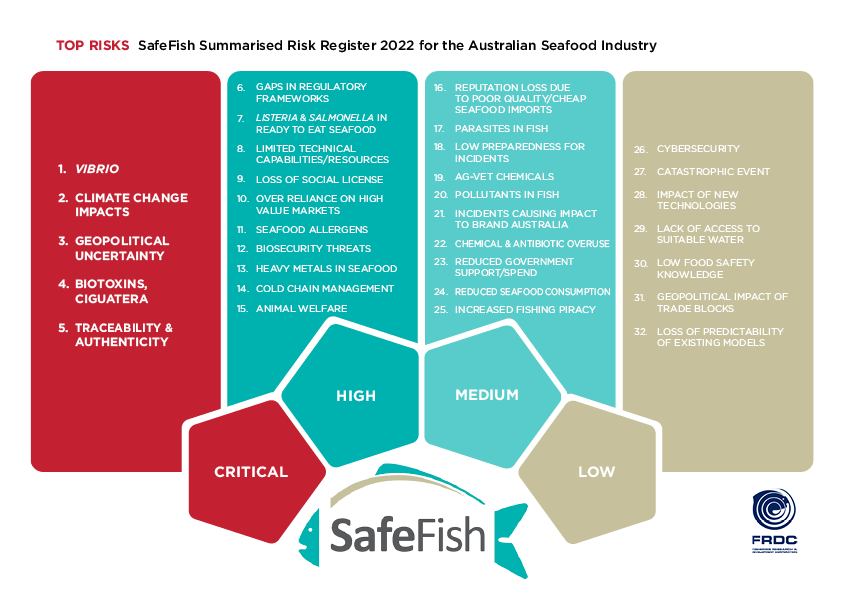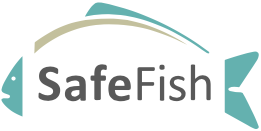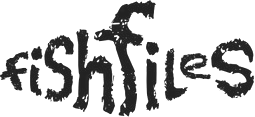Recent global events, like the COVID-19 pandemic, economic and political volatility, and climate related disruptions, have highlighted the need for resilience and preparedness. The smart way to navigate an unpredictable future and fast changing environment, is to improve our risk management culture and maturity. SafeFish clearly identified this need for the Australian seafood Industry and has set up the Actionable Risk Register program to support their members to build better knowledge and tools in managing their most relevant risks.
The Risk Register program is a collaborative program to support industry in identifying and proactively reacting to the top food safety and market access risks that exist for Seafood nationally, as well as for individual sectors that have an interest in being involved in the process.
The program will provide the tools to ensure a positive future for seafood businesses by:
- Improving risk culture
- Understand the top risks and which we need to prepare for
- Develop a set of sector-specific or collective actions to mitigate impacts
- Build networks
- Raise awareness and understanding.
National Seafood Risk Register
In 2021/22 SafeFish with the assistance of an external consultant (CL Advisory) facilitated the National Seafood Risk Register process. 47 stakeholders across Industry, Government and Research collaborated with the project team to identify the top risks via an online survey, one on one interviews or through guided virtual electronic brainstorming sessions. In addition to this, three targeted ‘wild card’ experts with geopolitical, food industry, and crisis management expertise were also interviewed. A report was prepared which includes an overview of the process, the results and a deep dive investigation into causes and consequences for the top five risks. The following issues were identified as the top risks facing currently facing the Australian seafood industry as a whole:
The National Seafood Risk Register report can be downloaded here.
Vibrio Mitigation Plan
The issue of Vibrio was identified as the most critical risk facing the Australian seafood industry nationally. To assist with being prepared and mitigating the risk of Vibrio in seafood, a risk mitigation process was undertaken to formalise a plan. As of May 2023, a draft Mitigation Plan for Vibrio has been developed in consultation with a voluntary steering group that have expertise in the field of Vibrios. Once completed the plan will be uploaded and made freely available and will include the following information:
- Description of the risk, causes and consequences
- An assessment of the risk (severity, likelihood, current risk level, residual risk level, effectiveness of mitigation)
- Key sectors and states/territories impacted
- Existing knowledge and evidence: environmental, clinical, methodological and risk management
- Most relevant references
- Key experts
- Identified knowledge gaps
- Existing actions in place
- Short/long term proposed actions
- Teams assigned to progress actions/research
Sector Specific Risk Registers
To assist with identifying issues of concern specifically relevant at a sector level, the Risk Register project has now begun working with seafood sectors directly.
Bivalve Industry
In 2023, representatives from Oysters, Scallops and Mussels worked with the project team through virtual workshops, email brainstorming sessions, and phone interviews to identify the top risks facing the Bivalve sector. The top five critical risks identified were:
- The challenges of Vibrio risk management
- The growth and changes of harmful algal blooms and biotoxins
- The limitations in laboratory capabilities and capacity
- The low or inefficiency of data and knowledge sharing (i.e. a low food safety culture)
- The need to update and review the current standards for shellfish
To access the full report that has been prepared which details the process undertaken, and the top risks identified (including a summary of the risk, its relevance to industry, the existing actions in place to mitigate and further actions/collaborative opportunities that exist to address the issue) click here.
A two-page summary highlighting the main findings on what was found has also been prepared and can be downloaded here.
A video snapshot highlighting the process and findings of the risk register for the bivalve sector can be found by clicking here.




